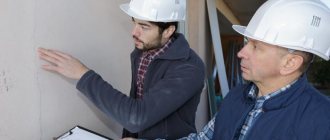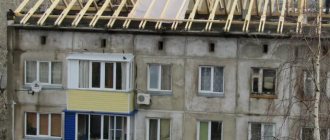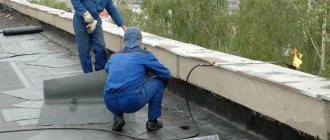Source: RosKvartal® - Internet service No. 1 for management organizations
Major repairs involve the complete renovation of a building - replacement or restoration of building structures, repair of utility networks and communications. The purpose of a major overhaul is to eliminate wear and tear or reduce the percentage of wear and tear of a building or premises, as well as maintain and restore its serviceability. Major works include large-scale work - replacement of the roof, plaster on the facade of the building, hot and cold water risers, etc. Major repairs of common property are carried out by decision of the general meeting of premises owners. Owners have the right to decide whether replacement of elements of common property is necessary in case of their obsolescence (clauses 21, 23 of the RF PP dated 08/13/2006 No. 491). Information that the house requires major repairs is reflected in the inspection report. In addition, the decision on major repairs can be made by federal executive authorities or state authorities of constituent entities of the Russian Federation - GZHN bodies, which exercise control over the use and safety of the housing stock (clause 22 of the RF PP dated 08/13/2006 No. 491).
Major and current repairs of the OS, unlike other recovery methods
In the production activities of organizations during the operation of the operating system, wear and tear of the operated objects naturally occurs, and breakdowns occur.
Their timely restoration allows you to increase their service life and avoid the cost of purchasing new equipment. Recovery is possible through modernization, reconstruction and repair. Modernization and reconstruction are recognized as work that improves or creates new technical and economic characteristics of an object. Whereas repair includes a set of measures aimed at replacing individual structures, parts, and maintaining its working condition. Repairs are divided into current and major. Current repairs are aimed at prevention, maintaining the facility in working order and eliminating minor faults. Capital - guarantees the restoration of the technical parameters of the object and its working condition.
Overhaul can be comprehensive, covering the entire facility, or selective, including the repair of individual parts of the facility.
The validity of OS repairs is established by the technical services of organizations by determining the order of scheduled preventive maintenance, while assigning the type of repair.
A feature of accounting for major repairs compared to other types of restoration is that repair costs are included in current costs, while costs for modernization and reconstruction are included in capital costs.
For key differences between repair and OS modernization for tax purposes, see ConsultantPlus. Trial access to the legal system is free.
List of overhaul measures
According to Part 3 of Art. 15 of the Federal Law of July 21, 2007 No. 185-FZ and Part 1 of Art. 166 of the Housing Code of the Russian Federation, major repairs include the following work:
- repair of in-house engineering systems of electrical, heat, gas, water supply, drainage;
- repair or replacement of elevator equipment deemed unsuitable for operation, and, if necessary, repair of elevator shafts;
- roof repairs;
- repair of basements belonging to common property in apartment buildings;
- facade repair;
- installation of collective (common house) meters for resource consumption and control units (heat energy, hot and cold water, electric energy, gas); repair of the foundation of the apartment building.
This is a list of works and services for the overhaul of public buildings in apartment buildings, financed from the capital repair fund, which is formed on the basis of the minimum amount of contribution for overhauls established by the regulatory legal act of the constituent entity of the Russian Federation.
The list can be supplemented with works (Part 2 of Article 166 of the RF Housing Code):
- on façade insulation;
- conversion of an unventilated roof to a ventilated one;
- on the arrangement of exits to the roof;
- on the installation of automated information and measurement systems for accounting for the consumption of utility resources and utilities;
- on the installation of common house meters for resource consumption;
- other types of services and works.
OS overhaul in accounting - postings
Once the decision on the need for a major overhaul of fixed assets has been made, the facility can be restored by the organization itself or by using equipment and workers from a third-party company on a contract basis. If you go the route of overhaul by the organization’s services, then you need to take into account that expenses will include the cost of spare parts and materials, wages, and insurance premiums.
Accounts for carrying out major repairs in various ways will be as follows:
- if there is a structural unit (repair service):
Dt 23 Kt 10 (16, 69, 70) - repair costs collected;
Dt 20 (25, 26, 29, 44) Kt 23 - expenses are written off depending on the use of the operating system (the account on which depreciation is recorded is debited);
- if there is no repair service, account 23 is not used, and the costs are written off directly to the cost account:
Dt 20 (25, 26, 29, 44) Kt 10 (16, 69, 70);
- If the repair is carried out by a contractor, the cost entry will be:
Dt 20 (25, 26, 29, 44) Kt 60.
For long-term overhauls, it is recommended to transfer objects to a separate subaccount of account 01 “OS under repair”.
For more information about what costs are considered justified, read the material “What are the costs of repairing fixed assets?”.
The recommendations of ConsultantPlus experts will help you write off materials for OS repairs in accounting and for income taxes. Get free trial access to the system and go to the Ready-made solution.
What is reconstruction
In Russian legislation there are several meanings of the term “reconstruction”, incl. in the Tax, Housing and Urban Planning Codes.
Definition of reconstruction according to the Town Planning Code
Reconstruction of capital construction projects
(except for linear construction projects) is a change in the parameters of a capital construction project, its parts (height, number of floors, area, volume), including superstructure, reconstruction, expansion of a capital construction project, as well as replacement, redevelopment and (or) restoration load-bearing building structures of a capital construction project, with the exception of replacing individual elements of such structures with similar or other elements that improve the performance of such structures and (or) restoration of these elements (Article 1, paragraph 14 of the Town Planning Code of the Russian Federation). An example of work with capital construction projects is the reconstruction of residential buildings and premises, public buildings, etc.
Reconstruction of linear objects
- this is a change in the parameters of linear objects or their sections (parts), which entails a change in the class, category and (or) initially established indicators of the functioning of such objects (power, load capacity, etc.) or which requires a change in the boundaries of rights-of-way and (or) security zones of such objects (Article 1, clause 14.1 of the Town Planning Code of the Russian Federation). An example of work with linear objects is the reconstruction of utility networks (water supply and sewerage systems, electrical, gas, thermal communications, etc.).
Interpretation of the concept of reconstruction in various regulatory documents
According to the Tax Code, reconstruction includes the reconstruction of existing fixed assets associated with the improvement of production and the increase of its technical and economic indicators, carried out under the project for the reconstruction of fixed assets in order to increase production capacity, improve quality and change the range of products.
It is obvious that the definitions of the term “reconstruction” given by the Tax and Urban Planning Codes differ significantly. The question arises: which definition should be followed, or does one complement the other? Then it turns out that reorganization is reconstruction?
However, in the Housing Code there is no definition of reconstruction, while the term “reconstruction” is synonymous with capital repairs, in terms of “replacement and (or) restoration of engineering support systems and engineering support networks.” It turns out that the interpretation from the Tax Code contradicts the Town Planning and Housing Codes?
Let's try to clarify. In accordance with paragraph 1 of Article 11 of the Tax Code of the Russian Federation (hereinafter referred to as the Tax Code of the Russian Federation), institutions, concepts and terms of civil, family and other branches of legislation of the Russian Federation used in the Tax Code of the Russian Federation are applied in the meaning in which they are used in these branches legislation, unless otherwise provided by the Tax Code of the Russian Federation.
Thus, if products are manufactured in a building (in other words, if the building in question is for industrial purposes) and these products are subject to tax, then it is necessary to be guided by the definition from the Tax Code. That is, reconstruction in this case will be the replacement and (or) installation of equipment with more advanced equipment, which can produce new products or allow increasing volumes or improving the quality of products. If it is intended to replace old, morally and physically obsolete equipment with new, modern equipment, then this will be technical re-equipment; in this case, it is allowed to change the production technology, but an increase in production capacity is not allowed and there is no talk about the quantity and quality of products.
Related Concepts
modernization can also be carried out
properties and technical characteristics of buildings, systems and elements. However, these concepts should not be confused, as they are complementary.
Reconstruction of a building differs from technical re-equipment
the optionality of changing the technological process and, on the contrary, the mandatory nature of replacing (restoring) load-bearing structures.
Redevelopment
during reconstruction is part of the concept of reconstruction of buildings and structures and includes work affecting the position of load-bearing walls and building structures.
Restoration
is often confused with reconstruction, but these concepts differ, mainly in that restoration includes work to strengthen and restore buildings and structures that are monuments of history, culture and art.
The reconstruction of houses and abandoned buildings in order to adapt them to modern needs, which is called renovation
buildings. For example, reconstruction and reconstruction of an abandoned plant or factory building with the aim of turning it into an office center.
Justification and confirmation of costs for major repairs
When carrying out major repairs of fixed assets, special attention should be paid to the order of registration of the process. During inspections, tax authorities place high demands on documentary evidence of repairs that have taken place.
First of all, the need for major repairs should be justified. To do this, a report is drawn up, which records the identified defects, or a defect sheet.
You can download a ready-made sample of a defect report from ConsultantPlus, receiving free test access to the system.
The transfer of an object for repair is formalized by an invoice for internal movement - in the case of repairs carried out by its own specialized service or an acceptance certificate if the object is transferred to a contractor.
After completion of the repair work, an acceptance certificate is drawn up, by which the object is accepted back. It is signed by members of the selection committee, persons responsible for the safety and repair of the OS, representatives of the contractor and can be drawn up according to the OS-3 form or a free one.
Documents confirming the actual costs of major repairs can be: estimates and technical documentation confirming the volume of repairs and costs for them, certificates of work performed from the repair organization or internal primary records for materials used for repairs, labor, etc.
Find out how to conclude a contract and fill out an acceptance certificate for completed work from the material “Acceptance certificate for completed work - sample for 2021.”
According to Appendix 9 of VSN 58-88:
APPENDIX 9 Recommended
List of additional work performed during major repairs of buildings and facilities
1. Inspection of buildings (including a comprehensive survey of the housing stock) and preparation of design estimates (regardless of the period of repair work).
2. Redevelopment of apartments that does not cause a change in the main technical and economic indicators of the building, an increase in the quantity and quality of services, equipment in apartments, kitchens and sanitary facilities; expansion of living space due to utility rooms; improvement of insolation of residential premises; elimination of dark kitchens and entrances to apartments through kitchens with the installation, if necessary, of built-in or attached premises for staircases, sanitary facilities or kitchens, as well as balconies, loggias and bay windows; replacement of stove heating with central heating with the installation of boiler rooms, heat pipelines and heating points; refurbishment of furnaces to burn gas or coal; equipment with cold and hot water supply, sewerage, gas supply systems with connection to existing main networks at a distance from the input to the connection point to the mains up to 150 mm; installation of gas ducts, water pumps, boiler rooms; installation of household electric stoves instead of gas stoves or kitchen fires; installation of elevators, garbage chutes, pneumatic garbage removal systems in houses with an upper floor landing level of 14 m and above; transfer of the existing power supply network to higher voltage; installation of television and radio antennas for collective use, connection to telephone and radio broadcast networks; installation of intercoms, electric locks; installation of automatic fire protection and smoke removal systems; automation and dispatching of heating boiler houses, heating networks, heating points and engineering equipment of residential buildings; improvement of courtyard areas (paving, asphalting, landscaping, installation of fences, wood sheds); equipment for children's, sports (except stadiums) and utility areas; dismantling of emergency houses; changing the roof structure; equipment of attic premises of residential and non-residential buildings for use.
3. Replacement of existing and installation of new technological equipment in buildings for communal and socio-cultural purposes.
4. Insulation and noise protection of buildings.
5. Replacement of worn-out elements of intra-block engineering networks.
6. Repair of built-in premises in buildings.
7. Examination of design and estimate documentation.
8. Design supervision of design organizations.
9. Technical supervision.
10. Carrying out repair and restoration work on monuments under state protection.
Results
OS overhaul is a step-by-step production process, each stage of which requires proper documentation.
When carrying out repair activities, it is important to justify the need for repairs, properly hand over and accept the object from repair and timely reflect the operations in accounting. You can find more complete information on the topic in ConsultantPlus. Free trial access to the system for 2 days.
Who doesn't pay for major repairs?
Citizens of the following categories have the right to full or partial exemption from making payments for major repairs:
- seniors over 70 years of age - a discount of half the contribution amount;
- elderly people over 80 years of age - complete exemption from payment;
- disabled people of groups I and II who own an apartment and live in it alone - a benefit in the amount of half the contribution amount.
5 nuances of filing a property tax return in 2020
Read
10 reasons to take away your apartment
Go
Preparatory work for room renovation
Preparatory work involves clearing the premises of everything that may interfere with the renovation, including household appliances and furniture. If necessary, they also dismantle old doors, windows, partitions and other structures. It is mandatory to remove the old finish.
Having completed the preparation of the premises, you can begin the actual implementation of major repairs. The first step is to carry out electrical installation work. It is advisable to entrust them to qualified specialists, since any experiments or errors in arranging the electrical network can lead to serious consequences. It's also not worth saving here.
Upon completion of work related to the arrangement of the home electrical network, you can begin engineering communications. They usually mean sewerage, plumbing, heating and other systems. At this stage they also deal with plumbing. The necessary finishing work is carried out in the bathroom and toilet.
Having completed all of the above procedures, of course, in full compliance with the optimal sequence of actions, you can move on to the living rooms. New doors and windows are installed, after which the floors, walls and ceilings are updated.
Upon completion of the main stages of major repairs, construction waste is removed. The premises of the home are cleaned, after which the rooms are furnished with previously removed household appliances and furniture.
Summary
We found out that repair is either a global restoration of the premises (building) or the correction of existing breakdowns. This is a set of specific actions, the goal is to “revive” a specific property to life.
Capital and current, we found out, are similar, but have many differences. Despite the similarities, their main differences are: the current one does not require obtaining regulatory approvals and does not last long. Does not make global changes to the “skeleton” of the house, maintaining the original layout.
Major repairs require the collection of permits, are carried out with the agreement of the owners of the premises, and are carried out with the financial support of government agencies.
Order of conduct
The priority in which CR is carried out is determined at the level of executive legislation. The main role here is played by the current condition of the building and the optional urgency of carrying out work to improve its technical condition. The standard period for the Kyrgyz Republic is 30 years.
You can find the necessary information on this matter in regional development programs. They are compiled on the basis of data from the management company or HOA in whose department this or that house is located, and include information that relates to:
- the total lifespan of the house,
- dates of the initial overhaul,
- the total amount of contributions and arrears for their payment,
- degree of wear of building and engineering structures.
The urgency of repairs and the scope of work are influenced by the following factors:
- Loose and light soil causes unplanned shrinkage of the building. In this case, the first step is to inspect and reconstruct the foundation if necessary.
- Seismically dangerous region - requires the installation of a special retaining frame that prevents the collapse of individual elements.
- Permafrost - measures are being taken to drain water and install waterproofing barriers. Due to this, all the necessary conditions are created to prevent moisture from entering any part of the structure. Such systems are replaced every 25 years, with the exception of emergency cases when their failure threatens the life and health of residents.







